
polymerase chain reaction / PCR
Polymerase chain reaction, or PCR, is a laboratory technique used to make
multiple copies of a segment of DNA. PCR is very precise and can be used to
amplify, or copy, a specific DNA target from a mixture of DNA molecules. First,
two short DNA sequences called primers are designed to bind to the start and
end of the DNA target. Then, to perform PCR, the DNA template that contains the
target is added to a tube that contains primers, free nucleotides, and an
enzyme called DNA polymerase, and the mixture is placed in a PCR machine. The
PCR machine increases and decreases the temperature of the sample in automatic,
programmed steps. Initially, the mixture is heated to denature, or separate,
the double-stranded DNA template into single strands. The mixture is then
cooled so that the primers anneal, or bind, to the DNA template. At this point,
the DNA polymerase begins to synthesize new strands of DNA starting from the
primers. Following synthesis and at the end of the first cycle, each
double-stranded DNA molecule consists of one new and one old DNA strand. PCR
then continues with additional cycles that repeat the aforementioned steps. The
newly synthesized DNA segments serve as templates in later cycles, which allow
the DNA target to be exponentially amplified millions of times.
Further Exploration
Concept Links for further exploration

















